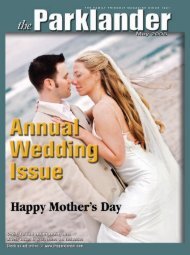September 2008 - The Parklander Magazine
September 2008 - The Parklander Magazine
September 2008 - The Parklander Magazine
Create successful ePaper yourself
Turn your PDF publications into a flip-book with our unique Google optimized e-Paper software.
FINANCIAL INFO<br />
Composing Your Financial Symphony<br />
By John Abrams<br />
My son, Matthew has just completed his first year at the Frost School of<br />
Music at the University of Miami. One of his objectives is to develop his<br />
craft of music composition. He has enlightened me with the sounds of<br />
Bach, Beethoven, Brahms, Roger Sessions, and John Cage.<br />
Any composer of serious music will tell you that creating a symphonic<br />
work is a delicate balance of sounds, melodies, dissonance and<br />
harmonies. Each instrument creates unique sounds, vibrations and<br />
timbres and when heard alone, may not create the effect intended by the<br />
composer. For instance, a flute may not have the colorful sounds, but<br />
when introduced with the sounds of oboes, French horns, and clarinets,<br />
you have the beginning of a masterful composition. Hence, the true art<br />
of creating a masterpiece is combining melodies, counterpoint and<br />
harmonies which results in intended blended sounds.<br />
In this respect, composers and investors share some similarities.<br />
Successful investing typically combines a number of different<br />
investments of various durations simultaneously in order to create a<br />
portfolio that is “in tune” with the investor’s goals and objectives. It’s no<br />
coincidence that such a technique is the foundation for one of the most<br />
basic financial investment principles- asset allocation.<br />
Asset allocation is the process of attempting to decrease financial risk by<br />
investing monies in different asset classes. <strong>The</strong> major asset classes that<br />
investors are familiar with include stocks, bonds, and cash; however, there<br />
are dozens of other asset classes, i.e., real estate, currencies, commodities,<br />
derivatives, etc., that can make up an entire masterful well- diversified<br />
portfolio. Mutual funds often represent a combination of asset classes, but<br />
they may consist of just one asset category, such as a gold fund. At that<br />
point an exchange traded fund (ETF) may be a better “instrument”<br />
because of liquidity, lower management costs and individual ownership.<br />
Overall, asset allocation may help reduce investment risk or “beta” while<br />
achieving potentially higher returns. That’s because different categories<br />
of investments react differently to specific changes in the economy,<br />
interest rates and geopolitical landscape.<br />
Now, in <strong>2008</strong>, stock values are plummeting within the major indexes,<br />
however bond values are also decreasing, especially those with shorter<br />
durations. This is due mostly to the Fed Chairman, Ben Bernanke,<br />
lowering the Fed Funds rate to 2.00 % which inversely raises the prices of<br />
those bonds. Does this necessarily lower the prices of stocks on Wall<br />
Street Not necessarily. As we saw the Fed lower the rates, we saw the<br />
stock market go up in prices.<br />
So, opposing correlations between asset classes typically reflect<br />
the supply and demand in those markets. For example: when the demand in<br />
bonds increase it’s usually because the interest rates are raised higher, and the<br />
money usually shifts out of the stock markets into bonds, because higher<br />
rates translate into higher costs for corporations and banks.<br />
<strong>The</strong> problem with trying to create an asset allocation today is that the<br />
stock market is now a bear market (20% down from its high on<br />
10/08/2007), and the bond yields are going up because of inflationary<br />
pressures. If you allocate into bonds, you will lose value as the bond yields<br />
move up, an inverse relationship. If you move into stocks, you will lose<br />
value as the Fed can’t lower rates any more to help spur more growth.This<br />
is the scenario of a recession that most economists will recognize probably<br />
later this year. If this recession becomes global, then it will become more<br />
protracted. So how do you asset allocate your portfolio <strong>The</strong>re are many<br />
asset classes to move into other than stocks, bonds, or cash.<br />
We’ll cover those asset classes next month when we compose our<br />
greatest composition that is music to our portfolios.<br />
132 SEPTEMBER <strong>2008</strong><br />
John Abrams is an Investment Specialist, and a Financial Services<br />
Representative for Cypress Financial Group, an office of MetLife.
















